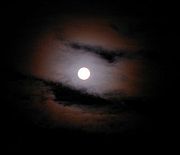
Atmospheric diffraction
Encyclopedia

- Fourier opticsFourier opticsFourier optics is the study of classical optics using Fourier transforms and can be seen as the dual of the Huygens-Fresnel principle. In the latter case, the wave is regarded as a superposition of expanding spherical waves which radiate outward from actual current sources via a Green's function...
is the bending of light rays in the atmosphereAtmosphereAn atmosphere is a layer of gases that may surround a material body of sufficient mass, and that is held in place by the gravity of the body. An atmosphere may be retained for a longer duration, if the gravity is high and the atmosphere's temperature is low...
, which results in remarkable visual displays of astronomicalAstronomyAstronomy is a natural science that deals with the study of celestial objects and phenomena that originate outside the atmosphere of Earth...
objects, such as depictions on this page.
- Radio waveRadio WaveRadio Wave may refer to:*Radio frequency*Radio Wave 96.5, a radio station in Blackpool, UK...
diffractionDiffractionDiffraction refers to various phenomena which occur when a wave encounters an obstacle. Italian scientist Francesco Maria Grimaldi coined the word "diffraction" and was the first to record accurate observations of the phenomenon in 1665...
is the scattering of radioRadioRadio is the transmission of signals through free space by modulation of electromagnetic waves with frequencies below those of visible light. Electromagnetic radiation travels by means of oscillating electromagnetic fields that pass through the air and the vacuum of space...
frequencyFrequencyFrequency is the number of occurrences of a repeating event per unit time. It is also referred to as temporal frequency.The period is the duration of one cycle in a repeating event, so the period is the reciprocal of the frequency...
or lower frequencies from the Earth's ionosphere, resulting in the ability to achieve greater distance radio broadcastingBroadcastingBroadcasting is the distribution of audio and video content to a dispersed audience via any audio visual medium. Receiving parties may include the general public or a relatively large subset of thereof...
.
- Sound wave diffractionDiffractionDiffraction refers to various phenomena which occur when a wave encounters an obstacle. Italian scientist Francesco Maria Grimaldi coined the word "diffraction" and was the first to record accurate observations of the phenomenon in 1665...
is the bending of sound waves, as the sound travels around edges of geometric objects. This produces the effect of being able to hear even when the source is blocked by a solid object. The sound waves bend appreciably around the solid object.
However, if the object has a diameter greater than the acoustic
Acoustics
Acoustics is the interdisciplinary science that deals with the study of all mechanical waves in gases, liquids, and solids including vibration, sound, ultrasound and infrasound. A scientist who works in the field of acoustics is an acoustician while someone working in the field of acoustics...
wavelength, a 'sound shadow' is cast behind the object where the sound is inaudible. (Note: some sound may be propagated through the object depending on material).
Fourier optics

Light
Light or visible light is electromagnetic radiation that is visible to the human eye, and is responsible for the sense of sight. Visible light has wavelength in a range from about 380 nanometres to about 740 nm, with a frequency range of about 405 THz to 790 THz...
travels through thin clouds made up of nearly uniform sized water
Water
Water is a chemical substance with the chemical formula H2O. A water molecule contains one oxygen and two hydrogen atoms connected by covalent bonds. Water is a liquid at ambient conditions, but it often co-exists on Earth with its solid state, ice, and gaseous state . Water also exists in a...
or aerosol
Aerosol
Technically, an aerosol is a suspension of fine solid particles or liquid droplets in a gas. Examples are clouds, and air pollution such as smog and smoke. In general conversation, aerosol usually refers to an aerosol spray can or the output of such a can...
droplets or ice
Ice
Ice is water frozen into the solid state. Usually ice is the phase known as ice Ih, which is the most abundant of the varying solid phases on the Earth's surface. It can appear transparent or opaque bluish-white color, depending on the presence of impurities or air inclusions...
crystal
Crystal
A crystal or crystalline solid is a solid material whose constituent atoms, molecules, or ions are arranged in an orderly repeating pattern extending in all three spatial dimensions. The scientific study of crystals and crystal formation is known as crystallography...
s, diffraction
Diffraction
Diffraction refers to various phenomena which occur when a wave encounters an obstacle. Italian scientist Francesco Maria Grimaldi coined the word "diffraction" and was the first to record accurate observations of the phenomenon in 1665...
or bending of light occurs as the light is diffracted by the edges of the particles. This degree of bending of light depends on the frequency (color) of light. The result is a pattern of rings, which seem to emanate from the sun
Sun
The Sun is the star at the center of the Solar System. It is almost perfectly spherical and consists of hot plasma interwoven with magnetic fields...
, moon
Moon
The Moon is Earth's only known natural satellite,There are a number of near-Earth asteroids including 3753 Cruithne that are co-orbital with Earth: their orbits bring them close to Earth for periods of time but then alter in the long term . These are quasi-satellites and not true moons. For more...
, planet
Planet
A planet is a celestial body orbiting a star or stellar remnant that is massive enough to be rounded by its own gravity, is not massive enough to cause thermonuclear fusion, and has cleared its neighbouring region of planetesimals.The term planet is ancient, with ties to history, science,...
or other astronomical object. The most distinct part of this pattern is a central, nearly white disk. This is an atmospheric airy disc
Airy disc
In optics, the Airy disk and Airy pattern are descriptions of the best focused spot of light that a perfect lens with a circular aperture can make, limited by the diffraction of light....
. It is distinct from rainbow
Rainbow
A rainbow is an optical and meteorological phenomenon that causes a spectrum of light to appear in the sky when the Sun shines on to droplets of moisture in the Earth's atmosphere. It takes the form of a multicoloured arc...
s and halos
Halo (optical phenomenon)
A halo from Greek ἅλως; also known as a nimbus, icebow or gloriole) is an optical phenomenon produced by ice crystals creating colored or white arcs and spots in the sky. Many are near the sun or moon but others are elsewhere and even in the opposite part of the sky...
, which are mainly caused by refraction
Refraction
Refraction is the change in direction of a wave due to a change in its speed. It is essentially a surface phenomenon . The phenomenon is mainly in governance to the law of conservation of energy. The proper explanation would be that due to change of medium, the phase velocity of the wave is changed...
.

Corona (meteorology)
In meteorology, a corona is produced by the diffraction of light from either the Sun or the Moon by individual small water droplets of a cloud....
, but true diffraction is not an effect of the solar corona
Corona
A corona is a type of plasma "atmosphere" of the Sun or other celestial body, extending millions of kilometers into space, most easily seen during a total solar eclipse, but also observable in a coronagraph...
.
On the right is a one tenth second shutter speed
Shutter speed
In photography, shutter speed is a common term used to discuss exposure time, the effective length of time a camera's shutter is open....
exposure showing presenting an overexposed full moon. The moon is seen through thin vaporous clouds which glow with a white disk surrounded by an illuminated red ring. A longer exposure would show more faint colors beyond the outside red ring.
Another form of atmospheric diffraction
Diffraction
Diffraction refers to various phenomena which occur when a wave encounters an obstacle. Italian scientist Francesco Maria Grimaldi coined the word "diffraction" and was the first to record accurate observations of the phenomenon in 1665...
or bending of light occurs when light moves through fine layers of particulate dust trapped primarily in the middle layers of the troposphere
Troposphere
The troposphere is the lowest portion of Earth's atmosphere. It contains approximately 80% of the atmosphere's mass and 99% of its water vapor and aerosols....
. This effect differs from water based atmospheric diffraction because the dust material is opaque
Opacity (optics)
Opacity is the measure of impenetrability to electromagnetic or other kinds of radiation, especially visible light. In radiative transfer, it describes the absorption and scattering of radiation in a medium, such as a plasma, dielectric, shielding material, glass, etc...
where as water allows light to pass through it. This has the effect of tinting the light the color of the dust particles. This tinting can vary from red to yellow depending on geographical location. the other primary difference is that dust based diffraction acts as a magnifier
Magnifier
A magnifier is a device used for magnification.Magnifier can also refer to:*Magnifying glass, an optical device for magnification*Screen magnifier, software that magnifies part of a computer screen...
instead of creating a distinct halo
Halo (optical phenomenon)
A halo from Greek ἅλως; also known as a nimbus, icebow or gloriole) is an optical phenomenon produced by ice crystals creating colored or white arcs and spots in the sky. Many are near the sun or moon but others are elsewhere and even in the opposite part of the sky...
. This occurs because the opaque matter does not share the lensing properties of water. The effect is to make an object visibly larger while being more indistinct as the dust distorts the image. This effect varies largely based on the amount and type of dust in the atmosphere.
Radio wave propagation in the ionosphere
The ionosphereIonosphere
The ionosphere is a part of the upper atmosphere, comprising portions of the mesosphere, thermosphere and exosphere, distinguished because it is ionized by solar radiation. It plays an important part in atmospheric electricity and forms the inner edge of the magnetosphere...
is a layer of partially ionized gases high above the majority of the Earth
Earth
Earth is the third planet from the Sun, and the densest and fifth-largest of the eight planets in the Solar System. It is also the largest of the Solar System's four terrestrial planets...
's atmosphere
Atmosphere
An atmosphere is a layer of gases that may surround a material body of sufficient mass, and that is held in place by the gravity of the body. An atmosphere may be retained for a longer duration, if the gravity is high and the atmosphere's temperature is low...
; these gases are ionized by cosmic rays originating on the sun. When radio waves travel into this zone, which commences about 80 kilometers above the earth, they experience diffraction
Diffraction
Diffraction refers to various phenomena which occur when a wave encounters an obstacle. Italian scientist Francesco Maria Grimaldi coined the word "diffraction" and was the first to record accurate observations of the phenomenon in 1665...
in a manner similar to the visible light phenomenon described above. In this case some of the electromagnetic energy is bent in a large arc, such that it can return to the Earth's surface at a very distant point (on the order of hundreds of kilometers from the broadcast
Broadcasting
Broadcasting is the distribution of audio and video content to a dispersed audience via any audio visual medium. Receiving parties may include the general public or a relatively large subset of thereof...
source. More remarkably some of this radio wave energy bounces off the Earth's surface and reaches the ionosphere for a second time, at a distance even farther away than the first time. Consequently a high powered transmitter
Transmitter
In electronics and telecommunications a transmitter or radio transmitter is an electronic device which, with the aid of an antenna, produces radio waves. The transmitter itself generates a radio frequency alternating current, which is applied to the antenna. When excited by this alternating...
can effectively broadcast over 1000 kilometers by using multiple "skips" off of the ionosphere.
An exotic variant of this radio wave propagation has been examined to show that, theoretically, the ionospheric bounce could be greatly exaggerated if a high powered spherical acoustical
Acoustics
Acoustics is the interdisciplinary science that deals with the study of all mechanical waves in gases, liquids, and solids including vibration, sound, ultrasound and infrasound. A scientist who works in the field of acoustics is an acoustician while someone working in the field of acoustics...
wave were created in the ionosphere from a source on earth.
Acoustical diffraction near the Earth's surface
In the case of sound waves travelling near the Earth's surface, the waves are diffracted or bent as they traverse by a geometric edge, such as a wall or building. This phenomenon leads to a very important practical effect: that we can hear "around corners". Because of the frequencies involved considerable amount of the sound energy (on the order of ten percent) actually travels into this would be sound "shadow zone". Visible light exhibits a similar effect, but, due to its much higher frequency, only a minute amount of light energy travels around a corner.A useful branch of acoustics dealing with the design of noise barrier
Noise barrier
A noise barrier is an exterior structure designed to protect sensitive land uses from noise pollution...
s examines this acoustical diffraction phenomenon in quantitative detail to calculate the optimum height and placement of a soundwall or berm adjacent to a highway.
This phenomenon is also inherent in calculating the sound levels from aircraft noise
Aircraft noise
Aircraft noise is noise pollution produced by any aircraft or its components, during various phases of a flight: on the ground while parked such as auxiliary power units, while taxiing, on run-up from propeller and jet exhaust, during take off, underneath and lateral to departure and arrival paths,...
, so that an accurate determination of topographic features may be understood. In that way one can produce sound level isopleths, or contour maps, which faithfully depict outcomes over variable terrain.
External links
- Explanation and image gallery - Atmospheric Optics by Les Cowley

